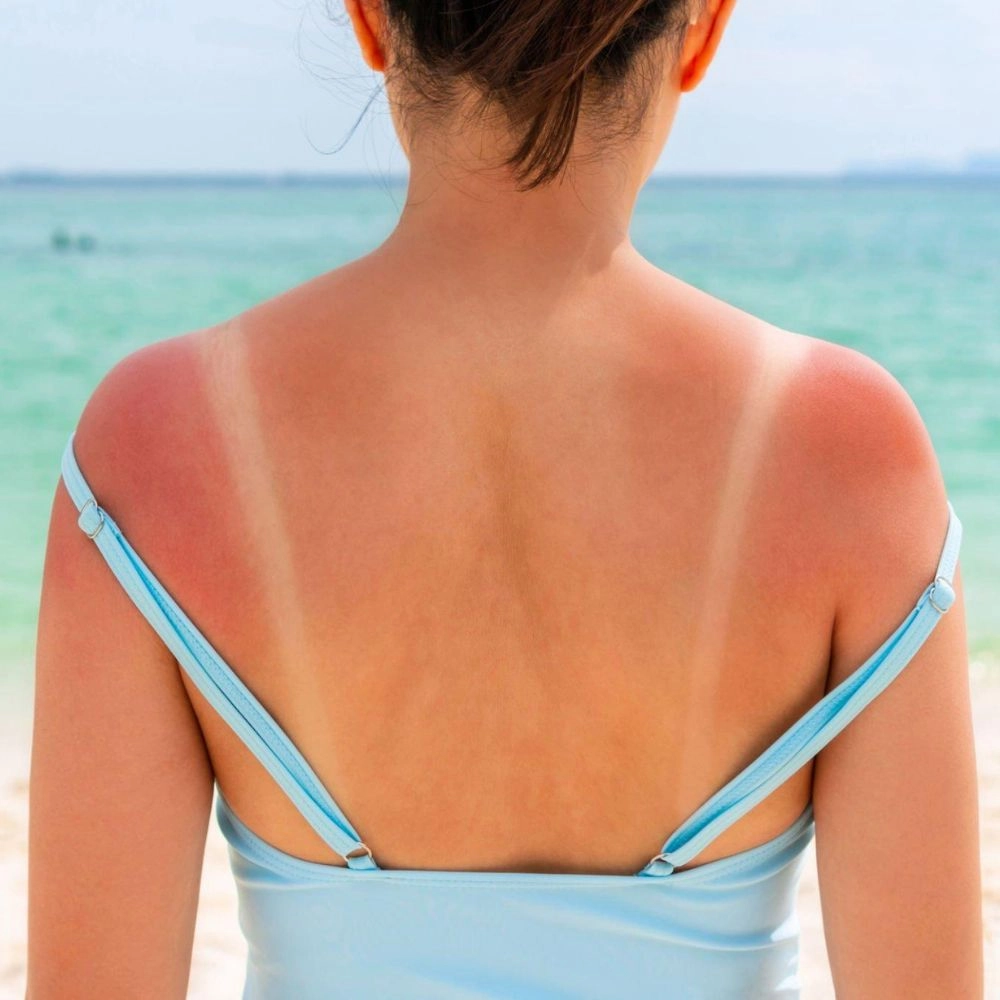Table of content
- Types of BREAST RECONSTRUCTION
- Procedure
- Risks and complications
- Pre-operation preparation
- Post-operative care
- Expected Results and recovery timeline
- Appointments and consultation
- Frequently asked questions
- Meet the team
- Pricing and payment plans
- Medical literature and research
- Support and counseling
- Send a message
SUN DAMAGE
INDICATION – BRIEF
Sun damage, or photoaging, is caused by prolonged exposure to the sun’s harmful UV rays, particularly UVA and UVB. It’s more prevalent in lighter-skinned individuals, those with certain genetic disorders, and older people due to lower skin repair capabilities. Non-clinical factors include living near the equator or at high altitudes, outdoor occupations or activities, inadequate sun protection, and use of tanning beds. Sun damage is cumulative and can be mitigated by using high SPF sunscreen, wearing protective clothing, and avoiding peak sun hours. Remember, it’s never too early or late to protect your skin from the sun.

INDICATION – DEFINITION
There are both clinical and non-clinical factors associated with sun damage.
Clinical factors
- UV radiation: The most direct cause is the ultraviolet (UV) radiation from the sun. There are two types of UV rays that reach the earth’s surface: UVA and UVB. Both of them can lead to skin damage. UVA rays penetrate deep into the dermis, the skin’s thickest layer, causing aging and wrinkling. UVB rays can burn the superficial layers of the skin and play a key role in the development of skin cancer.
- Skin Type: Individuals with lighter skin tones are more susceptible to sun damage because their skin contains less melanin, the pigment that provides some protection from the sun.
- Genetic factors: Certain genetic disorders, like xeroderma pigmentosum, increase susceptibility to sun damage due to defective DNA repair mechanisms.
- Age: Aging skin is more prone to sun damage. As we age, our skin’s ability to repair itself diminishes, and the effects of sun damage become more apparent.
Non-Clinical Factors
- Geographical location: People living in areas closer to the equator or at higher altitudes are exposed to more intense sunlight, which can cause more sun damage.
- Occupational and recreational exposure: If your job or recreational activities involve being outside during peak sunlight hours, you have a higher risk of sun damage.
- Inadequate sun protection: Failing to use adequate sun protection, like sunscreen or protective clothing, especially during peak sun hours, can lead to sun damage over time. This includes even on cloudy days, as up to 80% of UV radiation can pass through clouds.
- Use of tanning beds: Tanning beds emit UVA and sometimes UVB rays, both of which can cause long-term skin damage and contribute to skin cancer.
It’s worth noting that sun damage is cumulative, meaning it builds up over time starting from childhood. Therefore, it’s never too late or too early to start protecting your skin from the sun. Regular use of sunscreen with a high SPF, wearing protective clothing, and avoiding the sun during peak hours are among the measures that can be taken to prevent sun damage.
SYMPTOMS AND DIAGNOSIS
Symptoms
- Hyperpigmentation: This includes freckles, age spots, and larger discolored patches of skin (also known as melasma).
- Rough skin texture: Sun-damaged skin may feel rough or dry and may exhibit a leathery appearance.
- Wrinkles and fine lines: Prolonged sun exposure breaks down collagen and elastin, leading to premature aging of the skin.
- Redness and inflammation: Sunburn is an immediate sign of acute sun damage, but persistent redness can also be a long-term effect of chronic sun exposure.
- Visible blood vessels: The skin may show dilated or broken blood vessels, particularly on the face.
- Actinic keratoses (AKs): These are small, rough, raised bumps on the skin, which are precancerous and can evolve into skin cancer if left untreated.
- Skin cancers: Various forms of skin cancer, including basal cell carcinoma, squamous cell carcinoma, and melanoma, can develop as a result of prolonged sun exposure.
Diagnosis
Diagnosis of sun damage is typically based on a thorough physical examination of the skin. As a dermatologist, I would assess the extent of the sun damage by looking at the color, texture, and condition of your skin.
In some cases, a dermatoscope, a tool that provides a magnified view of the skin, might be used to assess pigmented lesions more clearly.
For any suspicious growths, like actinic keratoses or potential skin cancers, a skin biopsy may be performed. This procedure involves removing a small sample of skin for examination under a microscope to determine whether cancer or precancerous cells are present.
Prognosis and Impact

Prognosis
The prognosis for sun-damaged skin largely depends on the extent of the damage, the type of skin damage that has occurred (for instance, whether skin cancer has developed), and how effectively further sun exposure is managed.
Early and moderate stages of sun damage, characterized by dryness, pigmentation changes, and mild wrinkling, can often be managed quite effectively. Treatments such as topical retinoids, chemical peels, microdermabrasion, laser therapy, and other skin-resurfacing methods can significantly improve the appearance of sun-damaged skin and sometimes reverse precancerous changes.
More severe damage, such as actinic keratoses and skin cancers, require more intensive treatments. These may include cryotherapy, topical chemotherapies, excision, or Mohs surgery. For skin cancers, the prognosis can be quite good when detected and treated early. However, some forms of skin cancer, like melanoma, can be dangerous and potentially lethal if not caught early.
Impact
The impact of sun damage can be significant. Cosmetically, sun-damaged skin can lead to premature aging, causing individuals to appear older than they are. This can affect self-esteem and psychological wellbeing.
On the health side, chronic sun damage increases the risk of skin cancers, which can be disfiguring and, in some cases, life-threatening. Managing sun-damaged skin may also require ongoing dermatological treatment, which can be costly and time-consuming.
Treatment Options
- Topical Treatments:
- Retinoids: These Vitamin A derivatives can improve the skin’s texture and color, reducing the appearance of wrinkles and discoloration.
- Bleaching creams: Products with hydroquinone can lighten sunspots.
- Antioxidants: Topical antioxidants such as Vitamin C can protect against further sun damage and can help to repair existing damage.
- Chemotherapy creams: For precancerous lesions like actinic keratoses, topical treatments like 5-fluorouracil (5-FU) or imiquimod may be used to kill abnormal cells.
- Procedural Treatments:
- Chemical Peels: These remove the top layer of skin to reveal healthier skin beneath.
- Dermabrasion/Microdermabrasion: These procedures mechanically remove the top layer of skin.
- Laser Resurfacing: High-intensity light removes the damaged outer layers of skin.
- Photodynamic Therapy (PDT): A light-activated solution is applied to the skin, which is then activated with a specific wavelength of light to kill damaged cells.
- Microneedling: Tiny punctures in the skin stimulate the body’s natural wound healing process, increasing collagen production and improving skin appearance.
- Cryotherapy: For actinic keratoses and certain types of skin cancer, liquid nitrogen can be used to freeze off the abnormal cells.
- Surgical Excision or Mohs Surgery: For skin cancers, particularly those in cosmetically sensitive areas or large/complex lesions, the cancer may be surgically removed.
- Oral Medication: In some cases, oral retinoids may be prescribed to reduce the risk of skin cancer.
- Preventive Measures: Most importantly, future sun damage must be prevented with regular use of broad-spectrum sunscreen, avoidance of sun during peak hours, wearing protective clothing, and regular skin checks.
Risks and Side Effects
- Antiviral Medications: These are the standard treatment for herpes and include drugs like acyclovir (Zovirax), famciclovir (Famvir), and valacyclovir (Valtrex).
- Risks and Side Effects: While generally well-tolerated, these medications can cause side effects like nausea, vomiting, diarrhea, headache, fatigue, and rarely, more severe reactions like kidney issues or allergic reactions. Long-term use is generally safe, but regular follow-ups with a healthcare provider are needed to monitor for potential side effects.
- Topical Treatments: These include creams or ointments applied directly to the sores.
- Risks and Side Effects: Side effects can include skin irritation or rash where the medication is applied. Some patients may experience an allergic reaction to the topical treatments.
- Pain-Relievers: Over-the-counter analgesics may be used to manage pain associated with outbreaks.
- Risks and Side Effects: Potential side effects depend on the specific medication used, but they may include stomach upset, increased risk of bleeding, liver or kidney problems with overuse, and allergic reactions.
- Home Remedies: These may include cold compresses, baths with Epsom salts or baking soda to soothe the skin, or wearing loose-fitting clothing to prevent irritation.
- Risks and Side Effects: These treatments are generally safe, but in some cases, skin irritation may occur.
- Alternative Therapies: Some patients use supplements like lysine or apply substances like propolis, but evidence supporting these treatments is limited.
- Risks and Side Effects: The safety and efficacy of such treatments are not well-studied, so they may have unknown side effects. Supplements can also interact with other medications.
FAQ Section
Sun damage, or photoaging, refers to changes in the skin caused by prolonged exposure to the sun’s harmful ultraviolet (UV) rays. This can lead to wrinkles, discoloration, rough texture, visible blood vessels, and even skin cancer.
Signs of sun damage include hyperpigmentation (dark spots), fine lines and wrinkles, rough skin texture, redness, dilated blood vessels, and actinic keratoses (small, rough patches that can be precursors to skin cancer).
While some signs of sun damage can be improved with treatments like topical creams, chemical peels, and laser therapy, sun damage at a cellular level is largely irreversible. The focus should be on preventing further damage by practicing sun safety.
Yes, prolonged exposure to the sun’s UV rays can lead to skin changes that increase the risk of skin cancer, including basal cell carcinoma, squamous cell carcinoma, and melanoma.
You can protect your skin by applying broad-spectrum sunscreen with an SPF of 30 or higher, wearing sun-protective clothing and a wide-brimmed hat, seeking shade when the sun’s rays are the strongest (between 10 a.m. and 4 p.m.), and avoiding tanning beds.
If you notice signs of sun damage, it’s important to schedule an appointment with a dermatologist. They can assess your skin and recommend appropriate treatment or preventative measures.
Treatments for sun damage range from topical retinoids and bleaching creams to more intensive treatments like chemical peels, laser therapy, and even surgery for skin cancers. The best treatment depends on the type and extent of the sun damage.
Yes, while people with darker skin tones have more natural protection against the sun’s UV rays, they can still get sun damage and skin cancer. Sun protection measures are important for all skin types.
